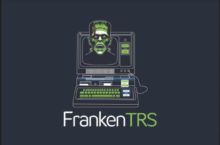(It even exceeded my own expectations)
The best laid plans
About this time I was also working on my NC beach house getting it ready for season (Tucs Beachin OBX House). I brought down with me :
- Repaired case
- Motherboard
- Power Supply
- 5 Pin DIN to Composite cable
- Composite to HDMI converter (JUST IN CASE)
- FreHD (If it was going to work, I’d want to be able to play)
- Retrostack Chargen replacement from Marcel Erz

My intention was twofold. I wanted to see just how good a signal I’d get from composite (The composite to HDMI was if it was a failure). The second was to install the replacement Chargen that I obtained from Marcel. Looking at instructions, it would have been just a quick pop into Z9 which is socketed. Right? What? It’s not. UGH. So I’d have to unsolder it, solder a socket, and then install. While talking to Marcel, he offered to do it. At first I was thinking I could, but only after 4 hours I realized that I need to understand my limits. So, packed it up and shipped it off from a local shipping place (Local in beach terms means an hour and 15 minutes. Driving 9 miles on unpaved beach is just the start)
Marcel did a bunch!
So while Marcel did it, he wanted to do it well and do it right. So the list turned from just being a socket for the Chargen to :
- Socket for Chargen
- Header pins to replace the keyboard/motherboard cable
- Replacing my “ROM daughter board” with the yet un-released “MultiRoms” (Diagnostic, Level I, multiple Level II version including 1.3 patched)
- Lower case kit
DRAMS and Video ram socketed(Decided not to do this)
Once he got into it though, the list grew. I had mentioned the keyboard was a bit wonky and he didn’t want it leaving without that being addressed. So the keys went into an ultrasonic cleaner, but still didn’t resolve it. Putting it under a microscope he found 8 of the 10 key switches had a bad solder joint. He ended up RE-SOLDERING THE WHOLE BOARD to be sure! That seems to have fixed the keyboard issue, but still a bit flaky. So another view with the microscope, and turns out one cold solder, and 10s of dry solder joints that also needed addressing. WOW. This would have been months of work for me.
So what’s all that look like?
Just a few pics of the things he did –




There is still more to go
I was considering another mod, wasn’t sure what would come of it, but figured I’d make the keyboard mod part of it and put it in the case, and if I didn’t end up using it, it was still there. The mod internally was just snipping wire 14 on the keyboard to motherboard connection. This is the *KBD signal (Which might give some indication why). As an option, you could put a switch (Which was provided). So after counting the wires a dozen times each way, I clipped the 2 wires that could be 14 (Depending on which I plugged the headers into), stripped them back, soldered a set of wires to it with a switch, and use some heat shrink to protect it.


And now even more
I wanted to still add more, but it came to a quandary. I could do the CP/M board called the “Omikron Mapper“, or the “Holmes Sprinter II” CPU speedup board. I had both from Ian Mavric (TRS-80 Universe on eBay). While CP/M is kewl, I had heard that if I was considering another mod (yet to be discussed) I’d need the faster CPU. So, that won out.
Installing the speedup is just popping out the Z80 –

and put the board in. Then just 4 solders. First blue

then red

and finally orange and yellow

and with that done, it now looks like –

Not sure at this point if I had anything more I could do, or room to do it in. 🙂 So, there’s everything done for the main unit. I ran all the wires out the EI port area, and now can –
- Change my fonts
- Change the ROM
- Connect/disconnect the *KBD signal
- Have lowercase
- Change CPU speeds
So, next, as we know I build out so the EI is next, right? Well, there’s something a bit closer than the EI next.
